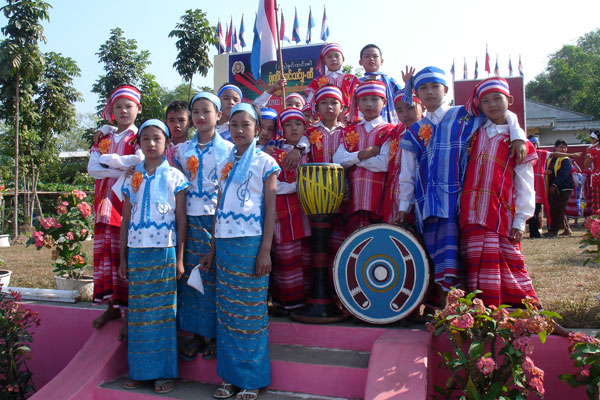 Kayin State, also known as Karen State, covers a total area of 11,731 square km. It shares borders with Mandalay Region and Shan State to the north, Kayah State and Thailand to the east, and Mon State and Bago Region to the west. The capital is Hpa-An and Mount Zwegabin is its most famous landmark. Thandaung is a picturesque hill station is the north of the state that is developing into a popular resot town.
Kayin State, also known as Karen State, covers a total area of 11,731 square km. It shares borders with Mandalay Region and Shan State to the north, Kayah State and Thailand to the east, and Mon State and Bago Region to the west. The capital is Hpa-An and Mount Zwegabin is its most famous landmark. Thandaung is a picturesque hill station is the north of the state that is developing into a popular resot town.
SURROUNDINGS (SIGNIFICENT TOWNS)
Myawaddy is a town on the Thai border with the newly-built road which connects Myawaddy with the rest of Myanmar, passing through the beautiful Dawna mountain ranges.
Thandaung was developed as a hill station during colonial times by the British and Mottama was captured by the British in the First Anglo-Burmese War of 1824-1826. Thandaung is a very beautiful station and an important tea, coffee and fruit producing region.
B&B WITH THANDAUNGGYI COMMUNITY BASED TOURISM
Thandaunggyi in Kayin State started offering B&B stays last year. Most Christian people are visiting to Thandaunggyi due to pilgrimage travelling. Travellers can visit the former British Hill Station, Tea Plantation and factory, Small Butterfly Village, Waterfalls & Hot spring in the surroundings of Thandaungyyi, New Bu Baw Mountain, and also explore traditional Bamboo Baskets, Forest Walks, Trekking Trails Cycling, Karen Festivals, Karen New Year Mountain, Harvesting.
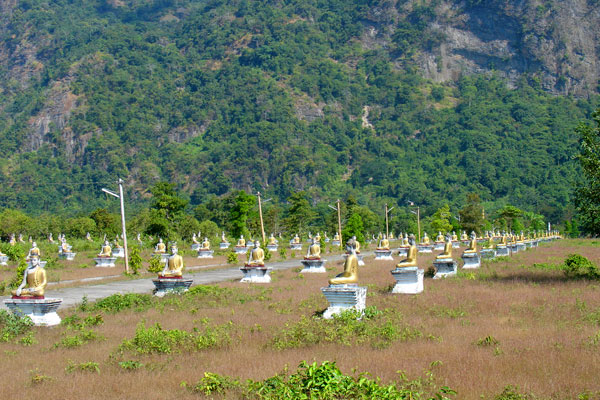 Hpa-an is a capital of Kayin State. Recently removed from the restricted list of travel destinations. Possible to reach it by road from Yangon across a new Bridge(Thanlwin) over the Thanlwin River. Hpa-an is small town but busy commerce center you can see farmer coming to town in horsecarts or trishaws stacked with baskets or mas to sell in the market.Most of people are kayin.
Hpa-an is a capital of Kayin State. Recently removed from the restricted list of travel destinations. Possible to reach it by road from Yangon across a new Bridge(Thanlwin) over the Thanlwin River. Hpa-an is small town but busy commerce center you can see farmer coming to town in horsecarts or trishaws stacked with baskets or mas to sell in the market.Most of people are kayin.
Hpa-an has a tropical monsoon climate (Koppen climate classification Am). Temperatures are very warm throughout the year, although maximum temperatures are some what depressed in the monsoon season due to heavy cloud and rain. There is a winter dry season (November-April) and a summer wet season (May-October).Torrential rain falls from June to August, with over 1,100 millimetres (43 in) falling in August alone.
Hpa-an is linked to Yangon, Mawlamyine and Hpapun by air.There are express buses from Hpa-an to Yangon, Mawlamyine, border trade of Myawaddy and other towns.
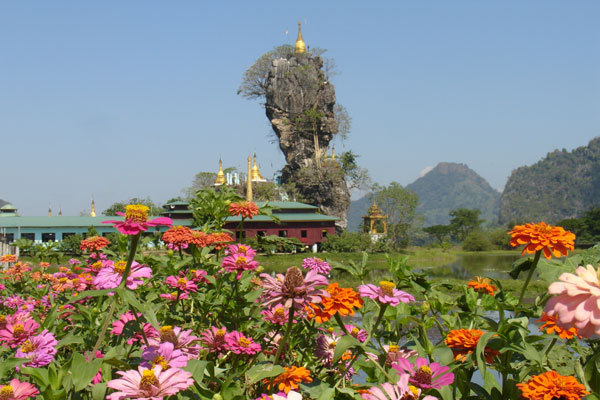 KyaukKaLat is a pagoda perched atop a sheer rock that rises out of an artificial lake. It is topped with a golden stupa making it unique. It was built near Hpa-An and surrounded by mountains and farmland. From the rock there are great views of the surrounding countryside and near by Mount Zwegabin. Many people visit to enjoy the sunset from there.
KyaukKaLat is a pagoda perched atop a sheer rock that rises out of an artificial lake. It is topped with a golden stupa making it unique. It was built near Hpa-An and surrounded by mountains and farmland. From the rock there are great views of the surrounding countryside and near by Mount Zwegabin. Many people visit to enjoy the sunset from there.
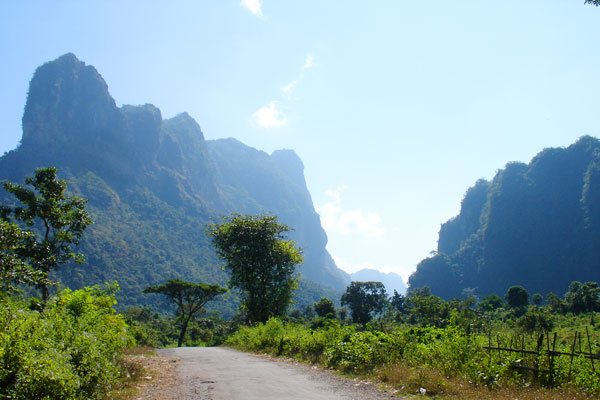 Mt.Zwegabin,at 722 m high is one of the most sacred mountains in Myanmar, with a monastery at its peak. Getting to the top requires a challenging two hour climb up a steep staircase. There is a monkey feeding event every day at around 11 am. Legend has it that there is a strand of the Buddha's hair enshrined in the pagoda. At the foot of the mountain, thousands of large statues of the Buddha can be seen.
Mt.Zwegabin,at 722 m high is one of the most sacred mountains in Myanmar, with a monastery at its peak. Getting to the top requires a challenging two hour climb up a steep staircase. There is a monkey feeding event every day at around 11 am. Legend has it that there is a strand of the Buddha's hair enshrined in the pagoda. At the foot of the mountain, thousands of large statues of the Buddha can be seen.
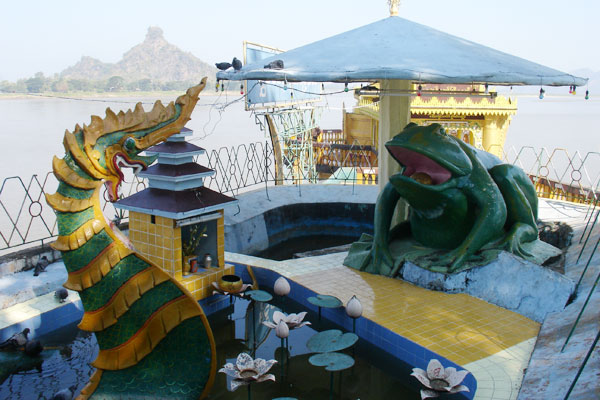 Shwe Yin Myaw Pagoda is located on the bank of Thanlwin River in Hpa-An town of Kayin State. The pagoda is the most famous in Hpa-An, and a favorite spot for tourists in watch the sunset. People visit Shwe Yin Myaw Pagoda and learn why the city is called as Hpa-An. Legend has it that Hpa-An was created by a dragon and a gaint frog. The impressive statues of these figures can be seen in the pagoda's compound.
Shwe Yin Myaw Pagoda is located on the bank of Thanlwin River in Hpa-An town of Kayin State. The pagoda is the most famous in Hpa-An, and a favorite spot for tourists in watch the sunset. People visit Shwe Yin Myaw Pagoda and learn why the city is called as Hpa-An. Legend has it that Hpa-An was created by a dragon and a gaint frog. The impressive statues of these figures can be seen in the pagoda's compound.
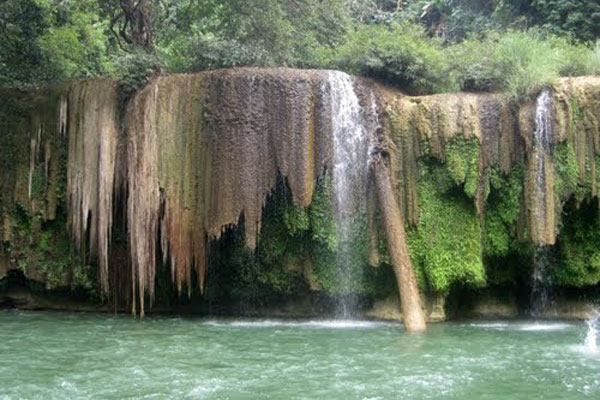 Kyone Htaw waterfall is next to Htiklawtho and is located at HoaingBwe town in Kayin State. Kyone Htaw waterfall is surrounded by a pristine forest. The waterfall is becoming a popular attraction for both local and forgein tourists who are drawn by the naturally green-coloured water. The best time to visit is at the drier times of the year.
Kyone Htaw waterfall is next to Htiklawtho and is located at HoaingBwe town in Kayin State. Kyone Htaw waterfall is surrounded by a pristine forest. The waterfall is becoming a popular attraction for both local and forgein tourists who are drawn by the naturally green-coloured water. The best time to visit is at the drier times of the year.
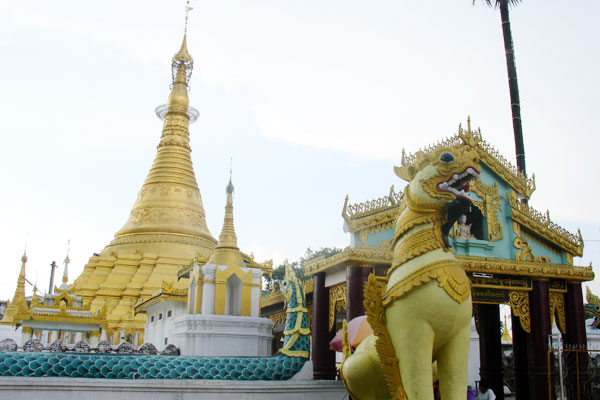 Myawaddy is a barder town between Myanmar and Thailand. It is connected to Mae Sot on the other side of the border.The border immigration between the two countries arranges the day-pass near the border.
Myawaddy is a barder town between Myanmar and Thailand. It is connected to Mae Sot on the other side of the border.The border immigration between the two countries arranges the day-pass near the border.
The Myawaddy market is full of all kinds of clothes, household goods, and vegetables were for sale.Threr is also the main pagoda in Myawaddy.
History of Significant Caves in Kayin State
The Kayin State is a state in the Union of the Republic of Myanmar in which many mountainous dense forest areas and caves are available. Natural caves, artificial caves and ancient caves with pagodas and Buddha images are available in Kayin State. The famous and significant caves in the state are Kawgunn Cave, Ratheepyan Cave, Saddan Cave, Bayintnyinaung Cave, Kawkathaung Cave, Dhatkyaik Cave and Weipyan Cave.
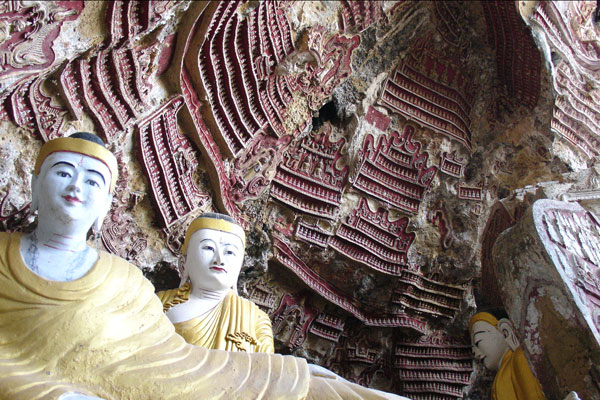 Kawgunn Cave is situated in Kawgunn Village in the west bank of Thanlwin River, approximately eight miles of Hpa-an. The chronicle said in 419 M.E (AD-1057), King Anawrahta waged war against King Manuhā of Thaton on account of seizing Tipitaka. King Anawrahta took ex-king Manuhā, scholars, and Tipitaka to Bagan. Queen of Mottama, one of the queens of ex-king Manuhā, evacuated from Thaton and reached Kawgunn Cave. While the queen was hiding in this cave, she made the sculptors to sculpture Buddha images, and pagodas inside the cave. She not only sculptured Buddha images and built pagodas in this Kawgunn Cave but also in other caves nearby. The Kawgunn Cave is the one of most interesting caves in Kayin State.
Kawgunn Cave is situated in Kawgunn Village in the west bank of Thanlwin River, approximately eight miles of Hpa-an. The chronicle said in 419 M.E (AD-1057), King Anawrahta waged war against King Manuhā of Thaton on account of seizing Tipitaka. King Anawrahta took ex-king Manuhā, scholars, and Tipitaka to Bagan. Queen of Mottama, one of the queens of ex-king Manuhā, evacuated from Thaton and reached Kawgunn Cave. While the queen was hiding in this cave, she made the sculptors to sculpture Buddha images, and pagodas inside the cave. She not only sculptured Buddha images and built pagodas in this Kawgunn Cave but also in other caves nearby. The Kawgunn Cave is the one of most interesting caves in Kayin State.
The area of this cave is 80 feet in length and 40 feet in wide. The cave is facing east. It is one sided open cave and has sufficient light. A cliff is over-shielding from one side that it escapes from raining and wind. The entrance of the cave is 10 feet high from the ground. The votive tablets of 3" to 4" were attached on the walls of the entrance and outside of the cave. Moreover, the Buddha images of ten feet to 15 feet high in different styles and mudra were sculptured. The inscription and Buddha images found inside the cave are the concrete evidences of Buddhism. It is learned that Kawgunn Cave has been used as an edifice for Buddhism. The study of ancient sculptures in this cave show the civilization of mankind who had settled in Kayin State. It could also investigate how ancient settler in the Kayin State established city states, and they could perform and practice their beliefs and customs.
In 2008, Ministry of Culture announced the Kawgunn Cave as Ancient Monumental Zone and Protected and Preserved Zone in order to protect ancient cultural heritage in this cave.This ministry made its preservations and conservations by issuing orders and by chemical preservations, and by educating the local people in preservation and conservation by collaboration with administrative and security officials for the sustainable preservation and safeguarding of sculptures and cultural heritages in the Kawgunn Cave. The festival of Kawgunn Cave is annually held on New Year day of Myanmar Era. The Kawgunn Cave is existed as living museum to study sculptures of votive tablets, Buddha images and ancient art and architecture.
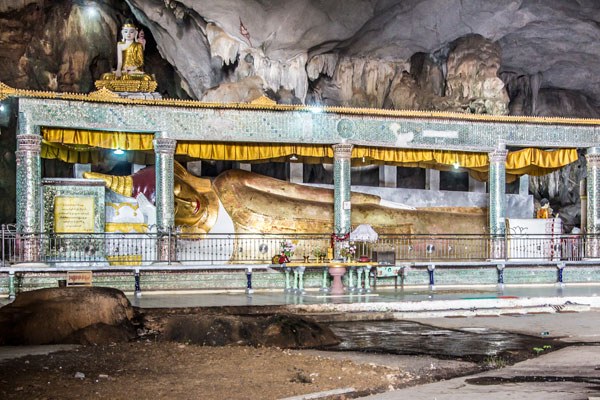 The Ratheepyan Cave is in Barr Kap Village near Than Lwin Bridge three miles far away from Hpa-an. The Ratheepyan Village is situated a mile to the south of Barr Kap Village, and Ratheepyan Mountain and Ratheepyan Cave are situated to the west of this village. The Ratheepyan Mountain is running from south to north and has 1,500 feet. A natural cave is available in a height of 150 feet at the foot of the mountain. That cave has an entrance and exit which can go through. The entrance of this cave is 75 feet wide and 150 feet wide inside the cave.
The Ratheepyan Cave is in Barr Kap Village near Than Lwin Bridge three miles far away from Hpa-an. The Ratheepyan Village is situated a mile to the south of Barr Kap Village, and Ratheepyan Mountain and Ratheepyan Cave are situated to the west of this village. The Ratheepyan Mountain is running from south to north and has 1,500 feet. A natural cave is available in a height of 150 feet at the foot of the mountain. That cave has an entrance and exit which can go through. The entrance of this cave is 75 feet wide and 150 feet wide inside the cave.
The votive tablets of 3" to 4" height and Buddha images of 5 to 6 feet height were put against the wall inside the cave and on the cliff outside the cave. The ruined votive tablets were renovated by archaeological and national museum department. A stone motor where the hermit grinded is available below the right side of seven Buddha images in the entrance of northern side of cave. The pilgrims touched this stone motor because they believed that by touching this stone motor and their suffering parts in their bodies will soon recover their diseases and sufferings.
Moreover, a stone chair and a stone plate grinded for medicinal herbs which was turned over by the hermit were found. In the center of this stone plate, a 4" depth concave is available which was believed to be grinded part by the hermit. Just as stone motor in the entrance of the cave, the pilgrims touched it. A stone plate where the hermit mediated, a hold which penetrated this Ratheepyan Mountain and a stone motor and a turned over stone plate for grinding are available in this cave. A stone flat cave is found behind the large pagoda in the center of cave. A hole on the roof of cave which was said to be a hole from which the hermit went through is situated above the pagoda.
Thus, the Ratheepyan Cave is famous because it is said to be a cave where a hermit attained power and he went up to the sky by penetrating the mountain. The pagoda festival of this cave is annually held during water festival. Since the Ministry of Culture is responsible to preserve and conserve ancient cultural heritage sites and to prevent deteriorating conditions of religious edifices, it has been conducting to demarcate as Ancient Monumental Zone and Protected and Preserved Zone in order to protect ancient cultural heritage in this cave.
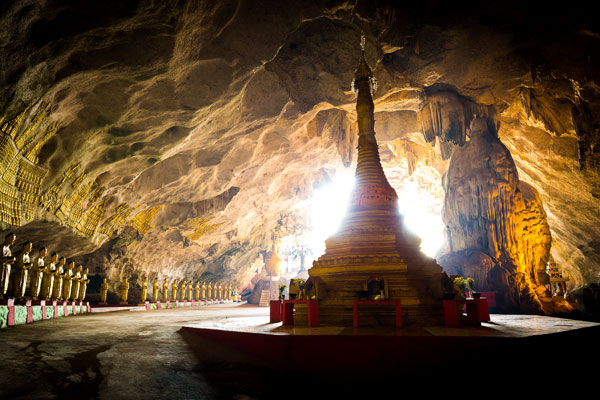 The Saddan Cave is one of the significant caves which are rich in Buddhist art and architecture. It is located about 20 miles away from Hpa-an. This cave is called ‘Htant Kama Khameik ( xefUurmhcrdkuf )’ in Kayin language. The word ‘Htant (xefU) means cave with one entrance , and ‘Kama (urmh)’ means reservoir which has four sided banks or fishing pond. The word ‘Khameik (crdkuf)’ means the plants called Kant Eit Pin. These plants are mostly grown on the embankments of lake. All parts of this plant, fruit, bud, and flowers are eatable. Thus, the name ‘Htant Kama Khameik( xefUurmhcrdkuf )’ means the place where lake and that plant is available.
The Saddan Cave is one of the significant caves which are rich in Buddhist art and architecture. It is located about 20 miles away from Hpa-an. This cave is called ‘Htant Kama Khameik ( xefUurmhcrdkuf )’ in Kayin language. The word ‘Htant (xefU) means cave with one entrance , and ‘Kama (urmh)’ means reservoir which has four sided banks or fishing pond. The word ‘Khameik (crdkuf)’ means the plants called Kant Eit Pin. These plants are mostly grown on the embankments of lake. All parts of this plant, fruit, bud, and flowers are eatable. Thus, the name ‘Htant Kama Khameik( xefUurmhcrdkuf )’ means the place where lake and that plant is available.
The environ of the Saddan Cave turns into vast water flooded area and a large lake is available in the southwest of this cave. It is 20 acres wide lake. Hsinhaing Mountain also known as Htant Baing Nar and a large pond are available in the south of this lake. This large pond is also known as a pond where Saddan elephant was resided. Many lime stalactites are amazingly found inside the Saddan Cave. Some stalactites look like elephants’ teeth and tusk in white colour. The Saddan Cave can go through to the other side of entrance, and two holes perforated by hunters are available. The place where stone saw was put up, the place where molar of the Saddan elephant was broken down, the place where intestines were pulling down called stone intestines, hunter hut, stone gridding plate and stone hitching post for elephant, and the things related to the story of the Saddan elephant are named. On account of having some stone structures likely to be elephant, this cave is known as the Saddan Cave.
A reclining Buddha of 30 taung and two seated Buddha images are found in the cave entrance. The wide of cave’s entrance is 100 feet wide and light can be visible up to 60 feet of distance from the cave entrance. At about that distance inside the cave, some pits of stone blood ( a kind of jelly like substance from stone) are available. After that stone pits, a saw like stone standing to a height of a man is believed to be the saw which cut the tusk of Saddan elephant. After this stone saw, a hole above the roof of the cave from which light comes through is found. It is believed that hole appeared when hunter Sawnuttra blew arrow to the Saddan elephant. A coin of stone stalactite is known as the Saddan elephant’s intestines.
A stone in the form of a hut can be found in a few distances away from stone intestines which is known as hut of hunter Sawnuttra. A stone in form of a molar can be seen beside it. After this place, a place called MokesoMyarpauk (where hunter blew his arrow) can be seen from a light passing through over the roof of cave. A stone post called hitching post of elephant can be found under the light. After walking a few distance from this stone post, one can reaches the other side of the entrance of cave. A large lake can be found in this entrance which is believed to be a bathing lake for the Saddan elephant. The length of the cave is two furlong long.
Monastery, sima, terraces, well and rest houses can be found on the bank of mountain near the cave’s entrance. The festival of Saddan Cave is annually held on the end day of Water Festival and the full moon day of Wakhaung. Since the ancient time, the cultural heritage of this cave was preserved by residing monks from the villages nearby. This Saddan Cave is the cave which can go through from entrance to exit and has many Buddhist art and architecture. Thus, this Saddan Cave is included as one of the best tourist attractions in Kayin State.
Situated on the west bank of Thanlwin River about 12 miles away from Hpa-an, Bayintnyinaung Cave was once called as Mahā Passana Yadanā Cave. Later, it was called Bayin Gyi Yadanā Cave and finally deviated as Bayintnyinaung Cave. The oral tradition says King Manuhā, his sons Sihā Kumāra and Sitta Kumāra evaded from Thaton and arrived at this cave. Since then, this cave is known as Bayintnyinaung Cave. Since this cave is situated on the mountain cliff, the pilgrims have to ascend to the mountain in order to pay worship votive tablets attached on the wall of that cave.
A Bo Bo Gyi nat shrine is available in the cave entrance. The pilgrims pay respects this shrine twice when they are in and out from the cave. The terrace of this cave is 200 feet wide and pagodas of three taung height are built on the wall of the cave. A plot of ancient votive tablets can be found on the roof to the left of the cave. Some ancient votive tablets were taken by the people that only imprints of these tablets are now found. Only very few votive tablets are remained today that this cave is the cave only very few votive tablets are available.
The Buddha images of five taung height inside the cave are housed in shrines because water is always seeping through rock crevices. The cave is 40 feet in length and 20 feet in wide. Two pagoda of three taung and seven taung height are found inside the cave. This Bayintnyinaung Cave is famous because there is a natural spa at the foot of the mountain where this cave is located. The pilgrims from near and far visited this cave not only for pay worship but also to bath in natural spa. The pagoda festival of this cave is annually celebrated on the full moon day of Tabaung. The Bayinnyinaung Cave is a famous cave in Kayin State because of its Buddhist art and architecture and natural spa.
The Kawkathaung Cave is near Kawkathaung village about seven miles away from Hpa-an. In the past, that village is covered with dense forest full of trees and bamboo and a mound. It is especially covered with ‘Kathaun (uoGefU )’ tree ( Kyo (MudKU) tree in Burmese) that this place was named as ‘Kokathaun (udkuoGefU )’ in Kayin. The word ‘Ko (udk)’ in Kayin refers to forest and ‘Kathaun’ means Kyo (MudKU) tree in Burmese. Thus, Kokathaun (udkuoGefU ) means the forest of means Kyo (MudKU) tree. Later ‘Kokathaun’ in Kayin has pronounced as ‘Kawkathaung’ in Burmese.
In the environ of Kawkathaung Cave, the entrance gate of cave, muzzle walls, wish fulfilling pagoda, a sanctuary lake, terrace of cave, dragon over shielded Buddha image, several Buddha images, flag mast, and tomb where the ash bone of Sayadawgyi was enshrined are seen. The 28 Buddha images, votive tablets, stone pillar in which dragon sculptures are wrapping, standing Buddha Images, crocodiles and tortoise statues, Ye Mingyi Buddha image, shrine of Sayadaw, relic chamber and small caves where old monks meditated are found inside the cave. This cave has no exit and the entrance of the cave is facing to the north. The entrance of this cave is 40 feet wide and 65 feet in length. The roof of this cave is 25 feet height in maximum and eight feet wide in minimum. The light from outside can be reached to 100 feet distance inside of the cave. Candle light or torch can be used to over 100 feet distance inside the cave.
On the wall to the left and right sides of cave have 56 seated Buddha images. A large Buddha image of nine taung height is placed inside the cave. Two seated Buddha images of five feet height are placed beside left and right sides of this central image. The inner side of this cave is 40 feet in wide and 50 feet in length. The roof is only eight feet height that light cannot be obtained sufficiently. A standing Buddha image of seven feet height and seated Buddha image of three feet height are available on the right wall of the cave. The inner part of this cave is narrower that it has only 15 feet wide and 20 feet in length. The roof is eight feet height in maximum and five feet in minimum. In this part, light is lighted because there is no sufficient natural light.
A relic chamber where relics were enshrined by old Sayadawgyi was found inside the cave. The floor of relic chamber is only six feet wide and four feet wide that only ten persons could sit and pay worship to the relic chamber. The entrance of relic chamber cave is fenced with iron rail but the relics can be visible through the rails. A lens is stood in front relic caskets. The relics are placed in gold and silver caskets. A pagoda of 1.9 feet was placed in the front, and a nine inches height pagoda was behind it and a gilded pagoda of 1.4 feet height is placed on a stone. In the environ of these pagodas, bronze Buddha images in standing, seated and reclining positions are available.
Apart from these Buddha images, contemporary and ancient votive tablets can be seen on the wall inside the cave. The pagoda festival of this cave is annually held in Tagu. The kawkathaung Cave is included as one of the historic caves in Kayin State. It is also regarded as sacred place in which many Buddhist art and architecture are available.
The Buddhist art and architecture and cultural heritage can also be found in Dhatkyaik Cave. This cave is situated at Kyauktalone Win Dayay Village which is five miles away to the north of Hpa-an- Thaton Motor road on the west of Than Lwin River. Previously this cave was called as Dankyaik( 'efusKduf or 'gefusKduf ) Cave. Mon people called this cave as Dhatkyaik ("usKdufor "gwfusKduf ) and Tan Dhatkyaik ( wefU"gwfusKduf ) in Kayin which means the cave where Buddha relics were available.
The cave is located above 300 feet height from the foot of mountain that it has free air inside. Many votive tablets and Buddha images are found inside the cave. These are sculptured by ancient people for worship. The votive tablets are 6", 3" and 2" height in sizes. The same size votive tablets are placed against the wall in role by role. However, only imprint of votive tablets remain today.
The broken statues could be found inside the cave and some were renovated. These Buddha images were six seated Buddha images each has 3 feet high, a seated Buddha image of 8 .6 feet high and 19 seated Buddha images of 2 .7 feet high. Moreover, a seated Buddha image of 5.2 feet and 12 seated Buddha images of 2 . 7 feet were also available. The pagoda festival of Dhatkyaik Cave was annually held on 10 waxing of Tabotwe.
Dhatkyaik cave is preserved and safeguarded headed by Win Daye Sayadaw and heads of the region . The devotees from Kyauk Talone , Win Daye , Naw Hpar Doe , Pyinn Kado Gone, Naw Ya Kone, Thit Phyu Pin Seik and Tada Oo villages and its environs are now trying to carry out for the propagation of Buddhism.
Weipyan Cave is included as one of the famous cave in Kayin State. This cave can be reached by sailing up to Than Lwin River from Hpa-an for about 24 miles up to Shwegunn Village. From Shwegunn, one has to sail up to Kaw Lon Island which is four miles away from Shwegunn. The Weipyan Mountain can be seen on the west bank of Than Lwin River to the opposite side of Kaw Lon Island and Komaung Village. The Wei Pyan Cave is available at the foot of Weipyan Mountain. This cave is situated on the border between Hpa-an and Hpa-pun townships. It is located on the cliff above 60 feet high from the ground. The cave entrance is 20 feet wide and 120 feet in length. The roof of Weipyan Cave is 30 feet height. According to oral tradition, a Mon King built this cave. The votive tablets and mural paintings inside this cave are contemporary with Kawgunn Cave that these two caves are built in same period. The Weipyan Cave is also called second Kawgunn Cave. Many Buddha images in various sizes are available inside the cave.
The Buddha images in seated positions, standing positions and reclining positions were sculptured on the roof and on the corner of the cave wall. On the higher level of the roof, some remains of votive tablets can be found. The faded mural painting can be seen on the eastern wall of the cave. The pagoda festival of Wei Pyan Cave is annually celebrated on the eve of Water Festival to the New Year day of Myanmar calendar. Although it is difficult to trace the history of Wei Pyan Cave, it is regarded as a distinguished cave full of Buddhist art and architecture.
Conclusion
Buddhism flourishes in Kayin State. Many caves are available in the state, the Kayin people since the ancient time built sacred Buddhist religious edifices in these caves. The most significant religious caves in Kayin State are Kawgunn Cave, Ratheepyan Cave, Saddan Cave, Bayintnyinaung Cave, Kawkathaung Cave, Dhatkyaik Cave and Weipyan Cave. The votive tablets, Buddha images in seated, standing and reclining positions are found. Among the votive tablets, some are ancient and some are contemporary sculptors. The sculptures in Weipyan Cave and Kawgunn Cave are contemporary. It is found that some ancient votive tablets are vandalized and some are taken by the people. Thus, the preserving and conserving these ancient votive tablets and Buddha images are essentially needed to safeguard cultural heritage in Kayin State.



